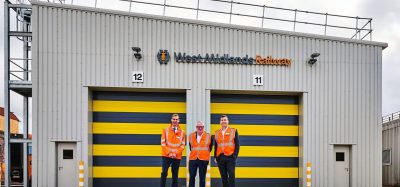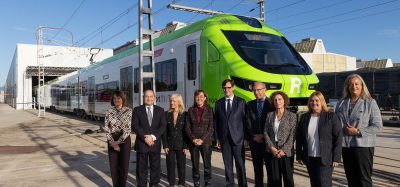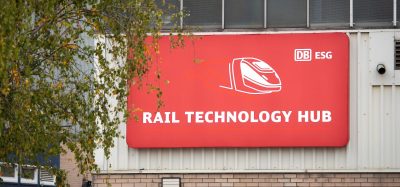Much-needed investment to modernise Czech infrastructure
Posted: 4 February 2016 | Anna Kodysová, Mojmír Nejezchleb | No comments yet
Despite the Czech Republic’s railway infrastructure being in a suitable condition, it still requires a lot of investment and intensive modernisation for it to fall in line with the quality of other railways of the European Union and Western Europe. Mojmír Nejezchleb, Deputy Director General, and Anna Kodysová, Head of the International Relations Department at the Czech Railway Infrastructure Administration (SŽDC), explain that recent investment has helped to improve some key sections, especially with the modernisation of large railway bridges on regional routes.
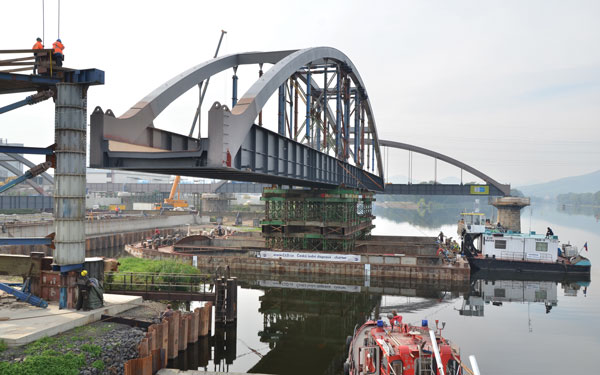

Rail Corridors
We have almost completed all four Czech ‘backbone’ corridors under European interoperable parameters. The backbone of the Czech railway network forms part of the defined Regulation concerning a European Rail Network for Competitive Freight (Rail Freight Regulation 913/20101) entered into force on 9 November 2010. It is thus part of the most significant European route which provides rail connections with important harbours, whether from the North Sea or the Baltic Sea.
SŽDC – the Czech Railway Infrastructure Administration (RIA) – is a member of the four Rail Freight Corridors (RFCs).
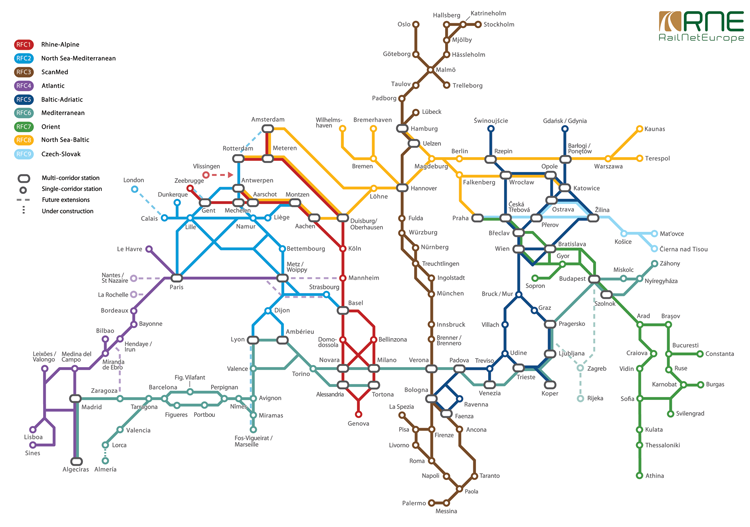

Other investments in the Czech railway infrastructure
In addition to modernisation of the aforementioned essential ‘backbone’ networks of the Czech Republic, redevelopment of large railway junctions are also in progress. Large projects carried out in 2015 include the modernisation of junctions in Ústí nad Orlicí, Olomouc, and Plzeň, plus the great construction project and development of new tunnels on the Rokycany–Plzen route (Ejpovice tunnel).
We have also concentrated on rail freight capacity projects, electrification projects for selected routes, and the development of the ETCS system in compliance with the approved National Implementation Plan.
Project financing
The Czech Railway Infrastructure Administration was as a national railway investor, successful in gathering subsidies from funds of the European Union. Projects were co-financed mainly from the Operational Programme Transport I (OPT); starting this year, we enter OPT II, and we will also use a new tool called the Connecting Europe Facility (CEF) where we were successful in the initial call with all five of our submitted applications. Together with Czech national resources, we had more than CZK 40 billions available for capital constructions in 2015, which has been a record-breaking amount since RIA’s foundation on 1 January 2003. Thanks to this financial ‘injection’, many projects could be carried out (approximately 100 construction projects were in progress on our network at the same time) which required demanding closure operations resulting in impacts on traffic continuity. On the other hand, after completing these investments, we will be able to offer a more modern and high-quality railway of European parameters to all rail carriers.
Regional investments
In 2015, and after some financial disposal and reorganisation, we were in a position to implement projects outside of the selected European railway network, i.e. on our regional railways – lines and sections that had been delayed for a number of years. We are aware of the fact that modern regional railway transport is greatly beneficial for the provision of the quality transport service within the region. One of the projects included rail modernisation in North Bohemia, Lovosice – Česká Lípa, with the restoration of a total of nine bridges – an investment of CZK 307 million; the most significant was the bridge over the Elbe River.
Bridge over the Elbe River in Lovosice
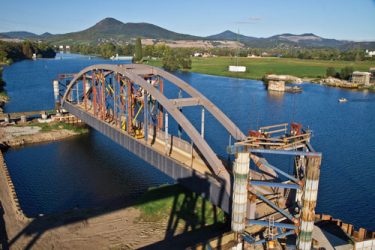

- The bridge has seven bays (Elbe and floodable zone)
- Support structure: steel, stiffened arched girder (Langer’s joist), with lower orthotropic deck with a rail bed, fitted vertically
- Bridging length: 336.2m
- Span: 3 x 74.37m
- Bridge width: 6.6m
- Bridge height: 7.1m (TK – common Elbe level)
- Building height: 2,500mm.
The project attracted a great deal of professional and public attention, especially with the replacement of steel support bridge structures to bays 3, 4, and 5. Each steel structure actually formed an independent bridge, so unique technology never seen before in the Czech Republic was chosen for their replacement, relying on ship and waterway operations.
Applying the Archimedes principle in practice
After several months of preparations, ‘D day’ arrived on 15 August 2015 when three connected river crafts – nicknamed ‘floating bays’ – lifted and moved the first of the three 19th century bridge structures – 75m-long and weighing 250 tonnes. The remaining two old steel giants followed later that month.
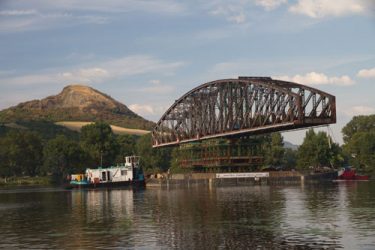

To disassemble the old bridge and install new bridge structures, the Archimedes principle was applied; to ‘lift up’ the 100-year-old structures, 250,000 litres of water needed to be pumped.
At the end of September to mid-October 2015, the demanding task of assembling the three new bridge structures took place. This took quite some time because they were not only 170 tonnes heavier than the previous structures, but also much bigger to ensure required technical parameters. The new bridge is capable of carrying a greater load – the rail bedding is not seated on bridging joists as in the original bridge, but on concrete ties in the ballast.
How was the new bridge fitted?
After demolition and removal of the last bay of the old steel structure, the new bridge structures started moving on carriages from the left Elbe River bank to heavy towers, which provided lowering and lifting of the whole load. The structure was lifted up to a height of 4.5m, which corresponded with the fitting height. On the floating bay, the structure was arranged on eight points using blocks providing evenly distributed loads. After the floating transport moved into the bridge opening, the floating bay was anchored in the river and the structure’s position was fitted. It was then laid aside on temporary supports with reinforced mounting points. The structure was released from the floating bay, which was subsequently filled with water up to the point when the whole bridge bay ‘pulls off’ from the blocks.
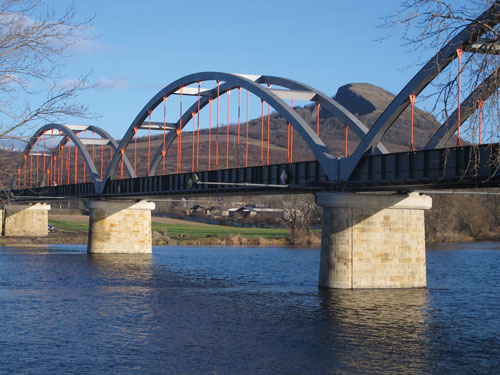

The project also included the restoration of the remaining four bridge bays and the other eight bridges, plus the builders also redeveloped the track superstructure. The use of modern superstructure material in selected parts of the route section now enables much higher transverse stress of the rail grid. This also contributed to increased speeds to 90km/h. Thanks to the new parameters allowing higher axle loads, heavier trains can now operate on this track section. The old bridge over the Elbe River served for almost 120 years; let’s hope the same applies to the new bridge.
Reference
- Based on Regulation (EU) No 913/2010, the map shown on page 00 was created by RNE and agreed with all RFCs. Any use without modifications of the map in electronic or printed publications is permitted with the explicit reference to RNE as the author and holder of the copyright.
Biographies




OUT NOW: The Definitive Guide to Rail’s Digital Future
The rail industry is undergoing a digital revolution, and you need to be ready. We have released our latest market report, “Track Insight: Digitalisation.”
This is not just another report; it’s your comprehensive guide to understanding and leveraging the profound technological shifts reshaping our industry. We move beyond the buzzwords to show you the tangible realities of AI, IoT, and advanced data analytics in rail.
Discover how to:
- Optimise operations and maintenance with real-time insights.
- Enhance passenger services through seamless, high-speed connectivity.
- Leverage technologies like LEO satellites to improve safety and efficiency.
Featuring expert analysis from leaders at Nomad Digital, Lucchini RS, Bentley Systems and more, this is a must-read for any rail professional.




